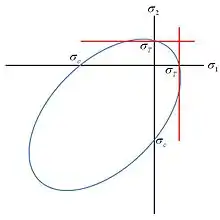Christensen failure criterion
The Christensen failure criterion is a material failure theory for isotropic materials that attempts to span the range from ductile to brittle materials. [1] It has a two-property form calibrated by the uniaxial tensile and compressive strengths T and C .
The theory was developed by R. M. Christensen and first published in 1997.[2][3]
Description
The Christensen failure criterion is composed of two separate subcriteria representing competitive failure mechanisms. when expressed in principal stress components, it is given by :
- Polynomial invariants failure criterion
For
-
(1)
- Coordinated Fracture Criterion
For
-
(2)
The geometric form of (1) is that of a paraboloid in principal stress space. The fracture criterion (2) (applicable only over the partial range 0 ≤ T/C ≤ 1/2 ) cuts slices off the paraboloid, leaving three flattened elliptical surfaces on it. The fracture cutoff is vanishingly small at T/C=1/2 but it grows progressively larger as T/C diminishes.
The organizing principle underlying the theory is that all isotropic materials admit a distinct classification system based upon their T/C ratio. The comprehensive failure criterion (1) and (2) reduces to the Mises criterion at the ductile limit, T/C = 1. At the brittle limit, T/C = 0, it reduces to a form that cannot sustain any tensile components of stress.
Many cases of verification have been examined over the complete range of materials from extremely ductile to extremely brittle types.[1] Also, examples of applications have been given. Related criteria distinguishing ductile from brittle failure behaviors have been derived and interpreted.
Applications have been given by Ha[4] to the failure of the isotropic, polymeric matrix phase in fiber composite materials.
See also
References
- Christensen, R. M.,(2010),http://www.failurecriteria.com.
- Christensen, R.M. (1997).Yield Functions/Failure Criteria for Isotropic Materials, Pro. Royal Soc. London, Vol. 453, No. 1962, pp. 1473–1491
- Christensen, R.M. (2007), A Comprehensive Theory of Yielding and Failure for Isotropic Materials, J. Engr. Mater. and Technol., 129, 173–181
- S. K. Ha, K. K. Jin and Y. C. Huang,(2008), Micro-Mechanics of Failure (MMF) for Continuous Fiber Reinforced Composites. Journal of Composite Materials, vol. 42, no. 18, pp. 1873–1895.
